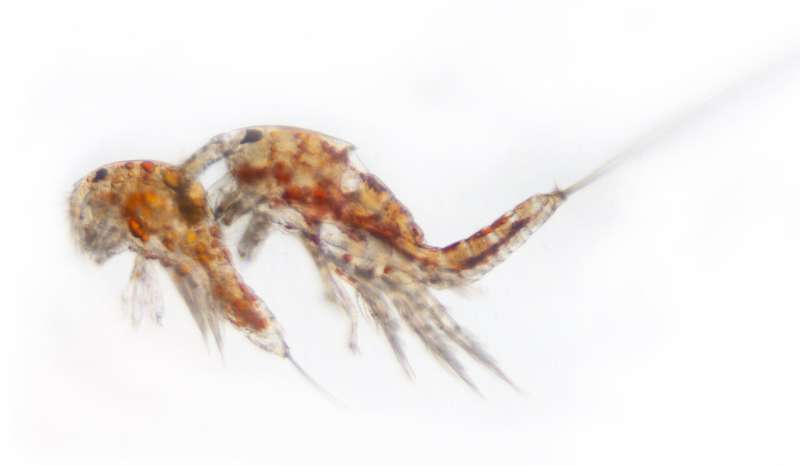Animals may have more than one means of surviving hypoxia

A tidepool crustacean's ability to survive oxygen deprivation though it lacks a key set of genes raises the possibility that animals might have more ways of dealing with hypoxic environments than had been thought.
Published in the Proceedings of the National Academy of Sciences, the findings by Oregon State University researchers are important because hypoxia—areas of low oxygen—is on the rise in waters around the globe, largely because of human-caused factors such as agricultural runoff, fossil-fuel burning and wastewater treatment effluent.
Hypoxia presents a major physiological challenge for animals, whose evolutionary history includes the development of cellular mechanisms to address changes in oxygen availability. The HIF pathway—hypoxia-inducible factor—is the primary mechanism animals use to sense and regulate oxygen levels.
The Pacific Coast crustacean Tigriopus californicus, however, is missing major genetic components of the HIF pathway, and doesn't have gills or respiratory pigment—a molecule, such as hemoglobin in humans, that increases the blood's oxygen-carrying capacity. Still, it's tolerant to extremely low oxygen levels for at least 24 hours in both its larval and adult stages.
Research by Oregon State University suggests that T. californicus may rely on other genes, those involved in cuticle reorganization and chitin metabolism, to successfully respond to hypoxic stress in its intertidal home; cuticle refers to a layer secreted by and covering the epidermis, the outer layer of skin, and chitin makes up a crustacean's exoskeleton.
RNA sequencing of animals exposed to conditions that were nearly anoxic—an extreme type of hypoxia—showed more than 400 genes being expressed, with the chitin metabolism and cuticle reorganization genes displaying consistent patterns of change during anoxia.
"That pathway is this small animal's potential solution to low oxygen availability," said study co-author Felipe Barreto, assistant professor of integrative biology in the OSU College of Science.
T. californicus has become an excellent model for studying physiological adaptations in the marine environment, said the study's lead author, Allie Graham, a postdoctoral researcher in Barreto's lab.
Last summer, Graham received a two-year National Science Foundation Postdoctoral Research Fellowship in Biology to look into how marine organisms cope with stressful environmental conditions, especially hypoxia. Patterns and mechanisms for T. californicus' hypoxia tolerance have largely been underexamined, she said.
"Hypoxia in ocean waters has been rapidly increasing in distribution, frequency and severity," Graham said. "Some coastal ecosystems even reach levels of anoxia seasonally. Low oxygen makes life difficult for a wide range of organisms, and generally fish and crustaceans have the lowest levels of tolerance."
T. californicus lives in pools that are primarily refreshed by waves as opposed to high tides, putting it and the pools' other residents under extreme environmental stress not just from low oxygen but also from fluctuations in salinity, acidity and temperature.
"With no respiratory structures or pigment, T. californicus likely relies on cutaneous diffusion to exchange carbon dioxide for oxygen," Graham said. "Its physiology might explain how it can tolerate the loss of that crucial HIF pathway and, in turn, co-opted other cellular stress-response mechanisms to keep its oxygen levels stable.
"As someone who had spent a large part of my doctoral work discussing the importance of the HIF pathway for animals in oxygen-limited environments, it was certainly a huge shock to not find these genes present in the T. californicus genome," she added. "The current literature discusses this pathway as though it was a given in all animals, which for vertebrates is crucial for blood vessel development and even plays a role in tumor biology. So the absence of these genes, the heart of the HIF-pathway, is intriguing."
More information: Allie M. Graham et al, Loss of the HIF pathway in a widely distributed intertidal crustacean, the copepod Tigriopus californicus, Proceedings of the National Academy of Sciences (2019). DOI: 10.1073/pnas.1819874116
Journal information: Proceedings of the National Academy of Sciences
Provided by Oregon State University



















